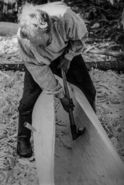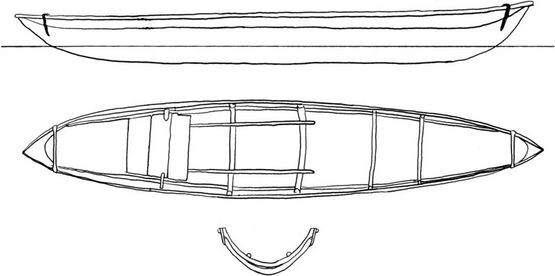Esping
A stretched dugout from Pomark in Finland, 1976
Esping means "aspen boat". When building an "esping", the first thing to do is to select a large aspen tree in the forest, fell it and cut the trunk to a suitable length. The trunk is then dug out with an axe so that its sides are quite thin. The opening in the centre should be kept quite narrow. After the trunk has been hollowed out, very hot wood tar is poured into it. This heats the wood sufficiently to make it pliable, allowing the sides to be stretched outwards where they are held in place by crossbeams and large rocks until the wood has again cooled down and stays in shape without help. To strengthen the boat, curved floor timbers are fitted and finally a plank is added clinker-fashion to each side of the boat in order to increase its height.
This simple "peapod-with-extra-plank" method of boatbuilding is well-proven in many other parts of the world, not least in the Far East and on the islands of the Pacific Ocean. In Denmark, imprints of 43 boats of this type, dated to about 300 AD, have been found at Slusegård on Bornholm.
"Espings" were used for travel on the lakes and rivers of inner Finland. Small "espings" were so light that they could very easily be carried or dragged from one lake to the next. Esping was built by Juho Nordlund from Pomark in 1976 and donated to the museum by the National Board of Antiquities, Maritime Museum of Finland, Helsinki. Small "espings" were propelled using a double-bladed paddle.
Currently the boat is in storage.
Information about Esping
Dockyard: Pomark (Finland)
Boatbuilder: Juho Nordlund
Owner: The Viking Ship Museum
Year of construction: 1976
Length: 4.18 meter (14 feet)
Width: 0.73 meter (2 feet)
Depth/draft: 0.20 meter (1 feet)
Height: 0.41 meter (1 feet)
Crew: 1 man (sometimes 2 men)





